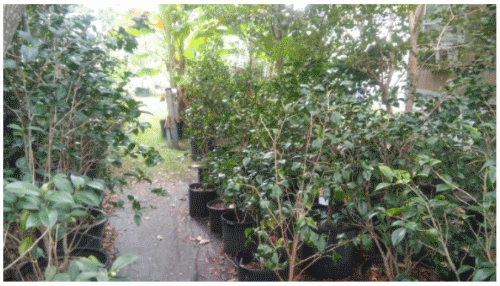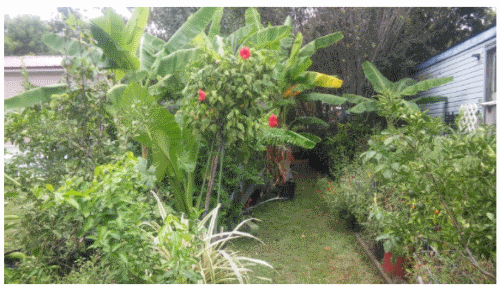This page contains affiliate links. We may earn money or products from the companies mentioned in this post through our independently chosen links, which earn us a commission. Learn More
In today’s world there is a push for perfection. Just turn on the TV and look at thecommercials. Brighter teeth, spot resistant carpeting, thin bodies, never a hair out of place, the list goes on and on. Even in the world of gardening there is a push to have a manicured lawn, trees that are perfectly branched, shrubs pruned just so, etc.
I am here today to yell, “STOP”!
I want to give you another, easier, less stressful choice for your garden and landscaping, it is called Wabi-sabi. In the ancient Japanese tradition, it basically means “the acceptance of that which is imperfect and aging gracefully”
You won’t find Wabi-sabi in Botox, glass-and-steel skyscrapers, I-phones, smart phones, or the drive for relentless self-improvement. It’s a beauty hidden right in front of our eyes. It is the balance between nurture and nature.
Now, before you go all crazy and say that it will not be pretty, a Wabi-sabi approach to life isn’t about giving way to carelessness or seeing a junk pile through rose-colored glasses. It’s about appreciating, showcasing, and sustaining the beauty of what’s natural.
Let me give you a couple of examples. Wabi-sabi is everything that today’s sleek, mass-produced, technology-saturated culture isn’t. It’s flea markets, not Wal-Mart or shopping malls; aged, preserved wood, not pristine hardwood flooring or tiles; Maybe it is a single Dandelion, not a dozen yellow roses.
The last time you were driving in the country and you saw an old abandoned barn, did you see a nasty old building, or a distinguished, elegant structure? That is Wabi-sabi.
When it comes to gardening, the Japanese are wise people, and they’ve been into messy gardening, or Wabi-sabi, since ancient times.
Some time ago, Diane Ackerman, who writes about gardens and gardening, was discussing her favorite topics. She said that our gardens reflect ourselves, which it is our way of looking at life. I thought this was a fantastic theory. My yard, full of Citrus trees and Camellias, food and competition, I like to compete in flower shows, and if you know me, I like to eat, was right on the mark. Then, later in the year, realization hit. As it does every year, nature had taken its course in my yard, and I hadn’t managed to keep it in check. The weeds had gotten bigger than some of my plants. I panicked, then I started to see images of country cottage gardens; my mother’s yard comes to mind. Weeds are simply uncultivated plants in their natural form, not genetically engineered by humans to produce bigger flowers or larger, visually interesting foliage, or bred to grow in a variety of soils and climate conditions. There is a LOT to be said for the insects that live in your garden needing local flora to survive, as do the birds, small mammals and amphibians that eat those insects. It’s a delicate natural balance and when traditional gardeners upset that balance, nature suffers. I recommend checking out this guide from weedeaterhero.com in case you’re looking for more info on choosing a Weed Eater for trimming grass
Going back to my mother’s yard, she is in a country like setting outside of Raleigh, NC; I am just outside of Charleston, SC. Here, they spray often to control mosquitoes, to no avail; they can suck the life right out of you. Her yard? Very few to any mosquitoes, she has an overabundance of frogs, lizards, fleas and other bug eating critters, including her chickens. She walks around her entire property and is shocked if she gets bitten once, in my yard, you can’t get to the bottom of the steps before a flock of 20 mosquitoes are buzzing around.
I have always ascertained that, if it is green, it is lawn. If the thought of creating a 100% weed-free lawn then spending the entire growing season mowing it, fertilizing it, watering it into a state of perfection leaves you feeling worn out and depressed, the growing trend for messy gardening is even better news. Unfortunately, many Homeowners’ Associations frown on unkempt yards, so you may need to balance that, but there are a few things you can do to make your life easier.
As soon as flowers die back and autumn arrives, traditional gardeners lop them off. Wabi-sabi means leaving the dead heads on for the winter, providing visual interest and homes for insects as well as food for wildlife in the way of seeds.
Allowing plants to grow through walls and pavement crevices is a blend of natural and man-made. Leaving old logs and trees to decay is a form of Wabi-sabi. It provides wildlife a place to hide, make a home and find food. You can even welcome weeds into your flowerbeds to provide contrast and interest. Add a variety of water features, everything from long channels of still water, like an old horse trough, to shallow dishes full of water that reflect light around and provide a drinking spot for birds.
I know that there are many places in America, and even around the world, that will frown upon this way of thinking, but if you reject traditional gardening for the laid back, Wabi-sabi style of gardening, you will be saving a whole load of time as a result. Now you can spend more of it enjoying your outdoor space, and less time fighting nature. I have included a few pictures of my yard, probably a little different that the traditional Was-sabi, but the effect is there. You walk around in different parts of the yard and it feels, quite, calm and peaceful. Isn’t that what the yard should be?
Happy Growing!
Darren



